



A very common question I see asked is what to use for an incubator. Often one can get by fine with no incubator at all, providing they have a spot in the house that holds a fairly stable warm temperature. This is more feasible with colubrid or many lizard eggs than with pythons however. But many are in my situation, where even in the herp room the temperature is not completely stable or always in the acceptable range. For these people an incubator will be required.
In most cases commercial incubators, aside from the Hovabators, are quite expensive and out of the price range fo the average hobbyist. Personally I am no fan of the hovabators, but they can work fine for someone who only needs to incubate a few gecko eggs.
For someone who has several clutches of snake or lizard eggs at a time, something larger is required.
Basically you need two things to hatch reptile eggs. The proper humidity, and the proper temperature for the species. How these two things are provided are not really important, as long as they are provided correctly.
I have used different techniques to incubate eggs over the years. My very first "incubator" was a rubbermaid sweater box with two heat rocks in it (at least I found a use for the rocks!). The temperature was controlled by taking one of the heat rocks in and out of the box as needed. This was primitave, but I did hatch quite a few day gecko eggs this way. It didn't take long though to decide that the amount of attention required was excessive, and other means would have to be devised.
Now I use old refridgerators or freezers as incubators. These are basically ideal. They come in a variety of sizes, have excellent insulation, and can normally be had for free or very little money.
I prefer uprght freezers myself. They have a single compartment and being upright, the egg boxes can be placed on shelves keeping you from having to move too many boxes to get to any one of them.
Standard refridgerators would work fine too. In fact, for some they may even be better. The fridge section can be converted normally, and the freezer part can be used for storage, or it can be made into a second incubator to be calibrated to a different temperature. This could be very handy when hatching leopard gecko eggs, or eggs from other species that demonstrate temperature dependant sex determination.
There are also very small, what I call "dorm room" refridgerators, which are basically a cube and can be placed most anywhere.
Finding an old freezer is normally not difficult. Try first at stores which sell or repair appliances, they will normally have some old ones sitting around waiting for disposal. In most cases you can get these for free, because in many places the buisness has to pay to dispose of them in the area landfill.
Private buisnesses are more likely to have some than large stores such as Lowe's. In my area, most small appliance stores will take away the old freezer being replaced as a service to the customer.
Let's look at how I convert an old freezer into an incubator. Click on any of the pictures to show a larger version.
The first thing I do is remove everything that provides the cooling for the freezer. This step is not required, but it will significantly reduce the weight of the incubator. Here are some pictures of this freezer before I began work on it.

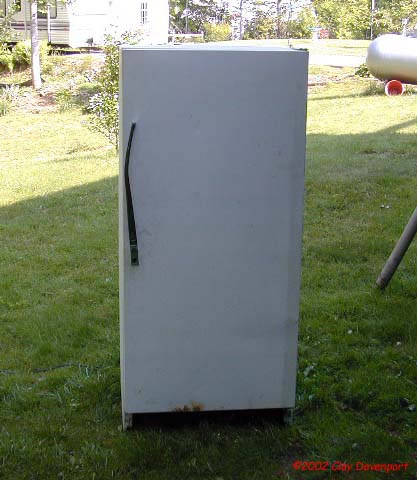


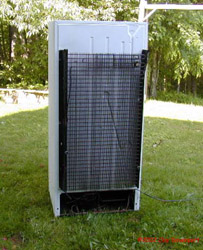
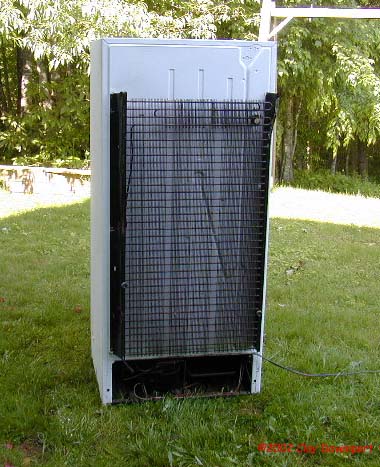
This is an older freezer, and yours may not look just like it. The newer models for instance do not have the coils on the back. Regardless though, basically all you need is the box and the shelves inside, everything else can be removed.
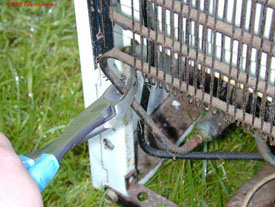
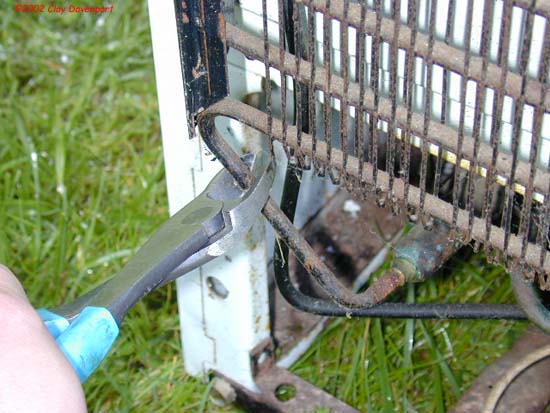
The first thing to do is to get the freon out of the system. Venting freon into the atmosphere is illegal today so you might consider having the freon removed by a certified professional. This freezer was drained prior to the cuting of the line.
Realistically though, I know most of you will just cut the line yourself and bleed it off, and for this reason I will include some safety precautions. Should you choose to do this, be extremely careful! Close and shield your eyes as you cut the line. The freon is under pressure and can cause injury. Should the freon spray in your eyes it will freeze them and blind you. It's a good idea to wear gloves as well. Stand to the side of the unit and reach around to cut the line.
Normally you will not be able to remove everything without cutting the line at some point, so it's best to have the system drained of freon so potential accidents are avoided should you break a line unexpectedly.
Once the line is cut just step away and allow the gas to escape, this could take several minutes.
Next I went to the bottom and removed the motor and coils from underneath. Just clip the wires as needed. You may also have to cut the copper tubing again to remove some parts. The system should be drained at this point, but excercise the same caution when cutting any of the copper tubing.
The second picture below shows everything I removed from this freezer. On newer models the amount of usless parts is less, and what you may find on your particular freezer will vary.

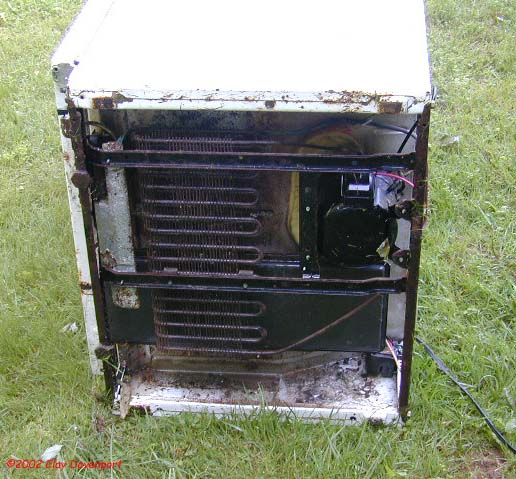
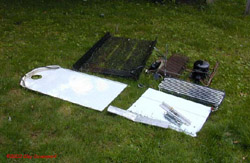

Now it's time to add the heater and thermostat. I find flexwatt heat tape to work very well for this purpose. For wiring instructions see my page on How to wire flexwatt. Other heat sources could be used, including ceramic heaters or even light bulbs. Flexwatt however, is both cheaper and more reliable.
First, drill a hole in the back large enough to get the wire for the heat tape through. The freezer walls consist of an inner and outer wall of metal with insulation in between. This insulation can make it very difficult to pass the wire through, so I use a piece of a coat hanger as shown. Put the hanger through the hole and tape the electrical cord to it, then use the heavy wire to pull the other through.
You will also need to drill an additional hole where ever you wish for the thermometer probe and the probe for the thermostat if you choose to use that type.
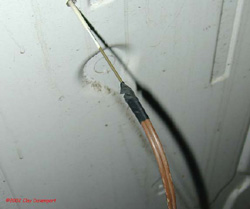
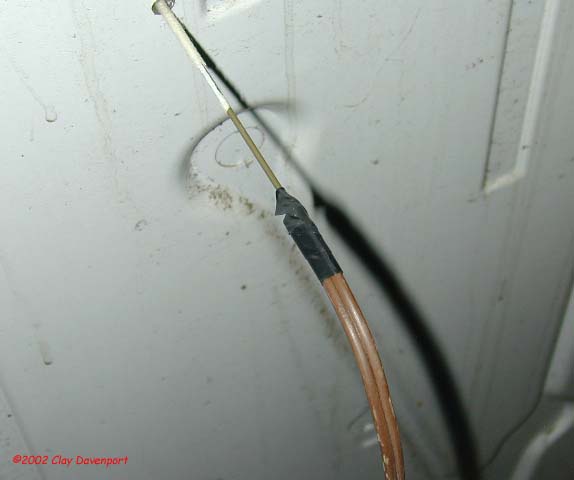
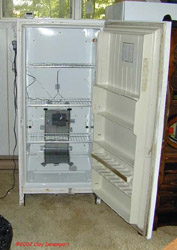



I initially chose to use two feet of 11" flexwatt, which is what you see in the pictures. However after testing it I found that this was not enough, as it only raised the temperature to 77-78. I needed the incubator as quickly as possible, and I had another two foot section already wired and not in use so I laid it inside as well.
Once the hatching season is over I will rewire the incubator to use a permanent three or four foot piece. The amount of heat tape required will depend on the size of the freezer, so you'll just have to test it to see.
For a thermostat I chose to use a ZooMed Repti-Temp 500R. For most uses these are quite acceptable and not too pricey. If very tight accuracy is needed I'd suggest going with a helix proportional thermostat.
A cheaper alternative would be a wafer thermostat as is used in Hovabators. I have seen these used, but haven't used them myself. I'm not entirely convinced of their reliability.
Once you get everything hooked up, you will need to calibrate it to the desired temperature. This process will take anywhere from a few hours to a couple of days, but it is very important, as you can easily lose eggs by placing them in the incubator before it is set to hold a stable temperature.
Altogether this incubator cost around $40 to assemble. Of that total $30 was for the thermostat.
If you had to purchase everything needed, including the digital thermometer used to monitor the temperature, expect to pay about $60 for the finished unit.
This is about twice the price of a hovabator, with about 20 times the capacity. A very good alternative to the incubator question for those needing a fair amount of space.
Additional Note: I have recently seen some criticism about my choice of using a "$30 thermostat" on an incubator. Apparently a few people think this is foolish and only trust thermostats such as Helix for incubator use. You should use whatever thermostat you feel comfortable with, but I will relate my first hand experience with this "$30 thermostat".
I have operated the incubator pictured on this page for the last two years. In that time it has run during all months of the year. The incubator sits in my cool room, so the room temperature varies from the mid 70s in the summer to 55 degrees in the winter.
I have two digital thermometers on the unit with min/max memory. During the entire time I have ran the incubator, I have never adjusted the thermostat after the initial calibration. The temperature shows a variance of +/- 1 degree, therefore I am fully satisfied with a $30 thermostat.
It's a display of the insulation capability of the freezer to maintain the temperature with that degree of accuracy even through 20 degree seasonal temperature changes in the room.